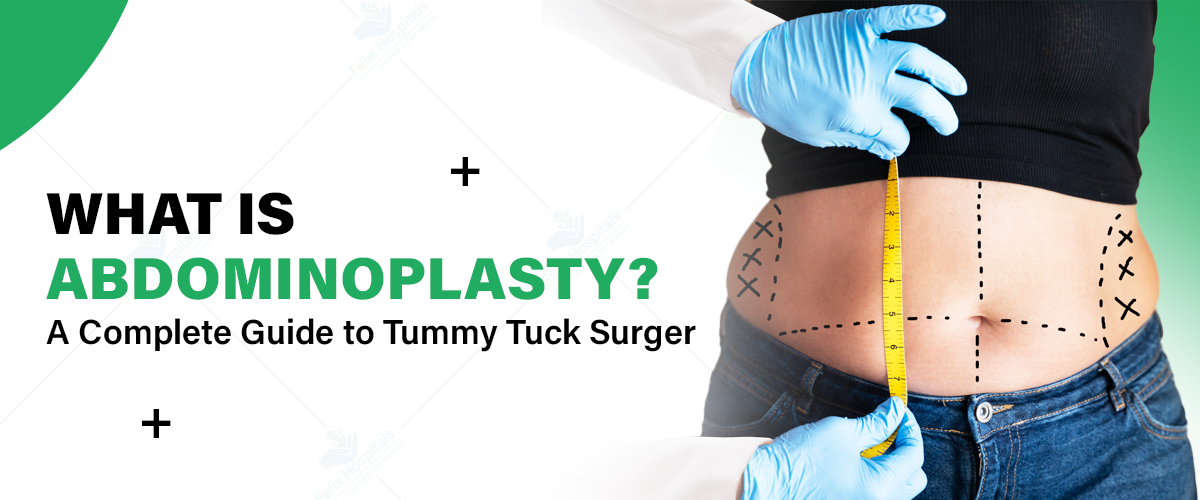
Subscribe to our

Abdominoplasty, commonly known as a tummy tuck, is a cosmetic surgical procedure that helps remove excess skin and fat from the abdomen, resulting in a smoother and firmer midsection. It is particularly popular among individuals who have lost a significant amount of weight or women post-pregnancy, where the abdominal muscles and skin have been stretched beyond their ability to recover naturally. If you're considering this procedure, finding a reputable plastic surgery hospital is essential to ensure safe and successful results.
Consult an experienced plastic surgeon today by Calling +91 9667064100 to explore how a tummy tuck can help you achieve your body goals.
Abdominoplasty is a surgical procedure that tightens the abdominal muscles and removes excess fat and skin to create a flatter, firmer abdomen. It is often sought by those who have experienced dramatic weight loss or pregnancy, which can leave the skin stretched and muscles weakened. The surgery can be tailored to the patient’s needs, ranging from a full abdominoplasty, which addresses the entire abdominal area, to a mini-abdominoplasty, which focuses on the lower abdomen.
Many people opt for abdominoplasty due to various reasons:
1. Post-Pregnancy Changes: Pregnancy often stretches the abdominal muscles and skin, leading to sagging and a protruding belly.
2. Significant Weight Loss: After substantial weight loss, excess skin can remain, which doesn't retract naturally, making abdominoplasty an option to contour the body.
3. Aging: As we age, the skin loses its elasticity, and fat accumulates in the abdominal area, leading to a drooping appearance.
4. Hernias: Some individuals undergo abdominoplasty in conjunction with hernia repair, particularly in cases where weakened muscles are present.
Low self-esteem due to dissatisfaction with the appearance of the stomach area.
Before undergoing abdominoplasty, a thorough consultation with a plastic surgeon is required. The surgeon will:
The procedure typically involves the following steps:
1. Anesthesia: The surgery is performed under general anesthesia to ensure the patient remains comfortable throughout the procedure.
2. Incision: The surgeon makes an incision above the pubic area, extending horizontally across the lower abdomen.
3. Muscle Repair: The underlying abdominal muscles are tightened and sutured to provide a firmer foundation.
4. Fat and Skin Removal: Excess fat is removed, and the skin is pulled taut before trimming the surplus. In some cases, liposuction may be used for better contouring.
5. Repositioning of the Navel: In a full tummy tuck, the belly button is repositioned to ensure a natural appearance.
6. Closure: The incision is closed using sutures, and a compression garment is placed to aid recovery.
Recovery typically takes a few weeks, during which patients are advised to avoid strenuous activities and follow the surgeon's post-operative care instructions closely.
While abdominoplasty addresses existing issues, maintaining results and preventing abdominal sagging can be achieved through:
Dr. Pragya Priya is a highly respected plastic surgeon specializing in abdominoplasty and other body contouring procedures. With years of expertise in cosmetic surgery, Dr. Priya provides personalized care and advanced surgical techniques to ensure optimal results with minimal scarring.
Schedule a consultation by Clicking Here with Dr. Pragya Priya, a leading plastic surgeon, to discuss your options for abdominoplasty.
Abdominoplasty, or tummy tuck surgery, is a highly effective solution for individuals looking to restore firmness and shape to their midsection. Whether it’s due to pregnancy, weight loss, or aging, a tummy tuck can help you achieve a flatter, more toned abdomen. By understanding the causes, symptoms, and treatment options for excess abdominal fat and sagging skin, patients can make informed decisions about their health and body. Consulting a skilled plastic surgeon ensures that the procedure is tailored to your specific needs, helping you achieve the best possible outcome.
1. What is abdominoplasty?
Ans: Abdominoplasty is a cosmetic surgery that removes excess fat and skin from the abdomen and tightens the abdominal muscles for a firmer appearance.
2. Who is a good candidate for a tummy tuck?
Ans: Good candidates are individuals in good health, who have excess abdominal fat or sagging skin due to weight loss, pregnancy, or aging.
3. What is the recovery time for abdominoplasty?
Ans: Recovery usually takes 4-6 weeks, during which patients should avoid strenuous activities and follow their surgeon’s post-operative care instructions.
4. Is abdominoplasty a weight-loss surgery?
Ans: No, abdominoplasty is not a weight-loss surgery; it is a body contouring procedure aimed at removing excess skin and fat after significant weight loss or pregnancy.
5. Will I have scars after a tummy tuck?
Ans: Yes, there will be scars, but a skilled plastic surgeon will place the incision strategically to minimize visible scarring. Over time, the scar should fade significantly.
6. Can I get pregnant after abdominoplasty?
Ans: Yes, you can still get pregnant after abdominoplasty, but it’s generally advised to wait until after you are done having children to preserve the surgery results.
7. What are the risks associated with abdominoplasty?
Ans: As with any surgery, there are risks, including infection, bleeding, scarring, and complications with anesthesia. It's important to discuss these risks with your surgeon.
8. How much does abdominoplasty cost?
Ans: The cost of abdominoplasty varies depending on the complexity of the procedure, the surgeon's expertise, and the location. Consult your surgeon for a detailed estimate.
9. What should I expect during the recovery process?
Ans: Expect some discomfort, swelling, and limited mobility during the first few weeks post-surgery. Wearing compression garments and following your surgeon's instructions will aid healing.